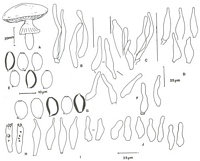|
 Agrocybe puiggarii Agrocybe puiggarii
SynonymsPholiota puiggarii
BiostatusOccurrence uncertain
Images (click to enlarge)
Caption: A-F Segedin 760, A. Habit sketch; B. Pilocystidia; C. Caulocystidia; D. Pleurocystidia; E. Basidiospores; F. Cheilocystidia. G-J Segedin 1723, G. Basidiospores; H. Basidia; 1. Pleurocystidia; J. Cheilocystidia. | 
Caption: O-S Segedin 1334, 0. Caulocystidia; P. Pleurocystidia; Q. Cheilocystidia; R. Basidiospores; S. Pilocystidia. |
Article: Watling, R.; Taylor, G.M. (1987). Observations on the Bolbitiaceae: 27. Preliminary account of the Bolbitiaceae of New Zealand. Bibliotheca Mycologica 117: 61 p. + 17 pl.
Description: Pileus 55-90 mm, convex then plano-convex, ochraceous yellow, paler at enrolled margin and sometimes ornamented with velar debris, cracking from edge to form areolae and show white flesh below, irregularly furrowed. Stipe 40-50 x 5-13 mm, cylindric, slightly clavate towards base, white at apex, annulate, tough, fibrillose-floccose and similarly coloured to pileus downwards, becoming cracked; ring thick, tough, floccose-flaky below, dark brown striate above from spores. Gills crowded, fairly thin, dirty brown grey, uneven with pale, wavy edge. Flesh white throughout almost continuous in pileus and stipe. Taste none; smell rather sweet sickly.
Basidiospores tobacco brown in mass, (10.25-) 11-12.5 x 6-6.5 µm, elliptic in side and face views, slightly flattened in side view, relatively thick-walled, yellowish brown in water and alkali solution; germ-pore distinct, central. Basidia 4-spored, cylindric 27-35 x 6-9 µm. Cheilocystidia numerous forming a thick wide fringe, narrowly lageniform, 40-60 x 5-10 µm with flexuous neck 25-30 µm long and obtuse head, tapered or not and 4-6 µm broad, some almost cylindric, hyaline; pleurocystidia ventricose-mucronate or ampulliform 32-46 x 10-14 µm with mucro 1-2 µm broad, hyaline. Hymenophoral trama regular with some oleiferous-like, yellow hyphae. Pileipellis a mixture of pyriform, pedicellate swollen cells >25 µm broad intermixed with many filamentous-cylindric, hyaline hyphae and fewer, similar yellowish hyphae 4-6 µm broad. Stipitipellis above ring with lines of clusters of variable cells many similar to those on gill margin or flexuous, filamentous, some pyriform. Clamp-connections present.
Habitat: On ground or on old wood in disturbed areas.
Notes: This species was originally described, as Pholiota based on a collection from grassy fields at Apiahy, Brazil. Singer (1950) recognised it as an Agrocybe and placed it close to A. praecox and A. molesta (Lasch) Singer (= A. dura (Bolt.: Fr.) Singer).
There is evidence that this species may be more widespread than the literature suggests and that it may occur in New Zealand. Three collections with characteristic flexuous filamentous to lageniform cheilocystidia and mucronate-vesiculose pleurocystidia were located amongst the material in PDD. Unfortunately little field data accompanies the collections so the identifications are meantime preliminary. It, however, indicates that yet another member of Agrocybe sg. Agrocybe is to be found in New Zealand and fresh collections to substantiate the record are urgently required. The New Zealand material had the following characters:
|